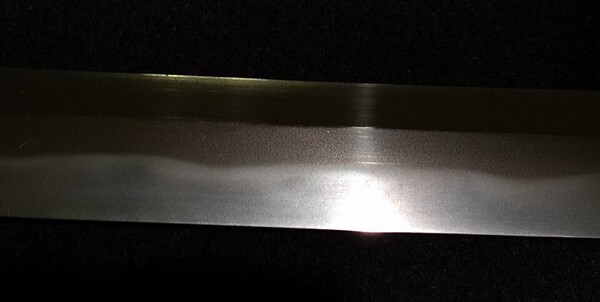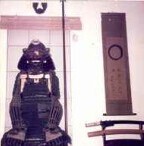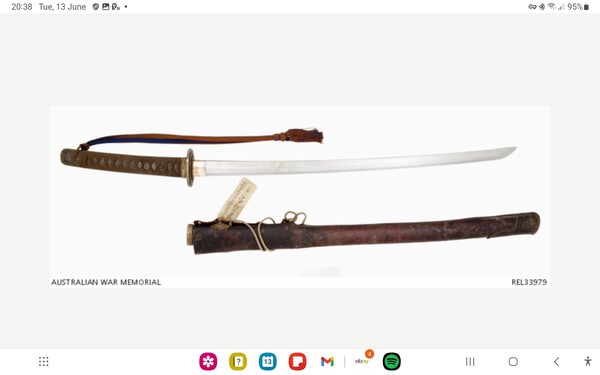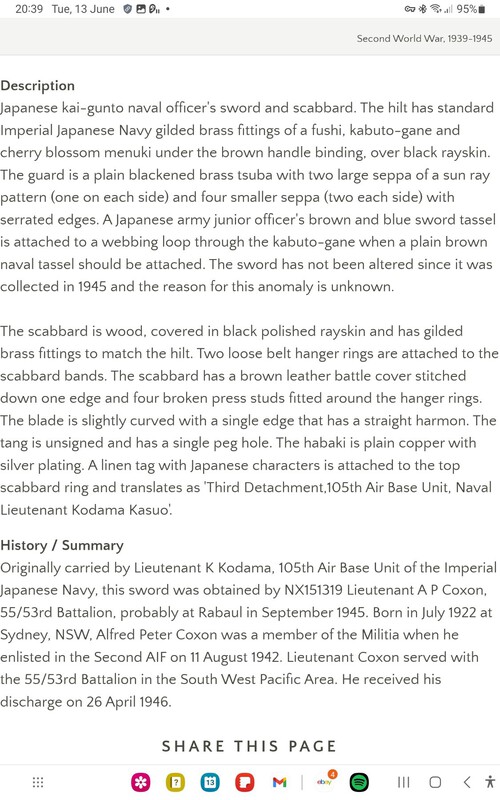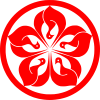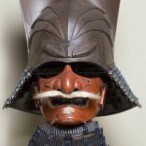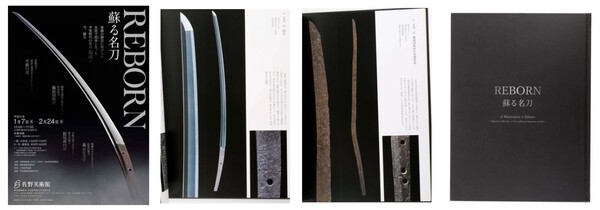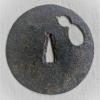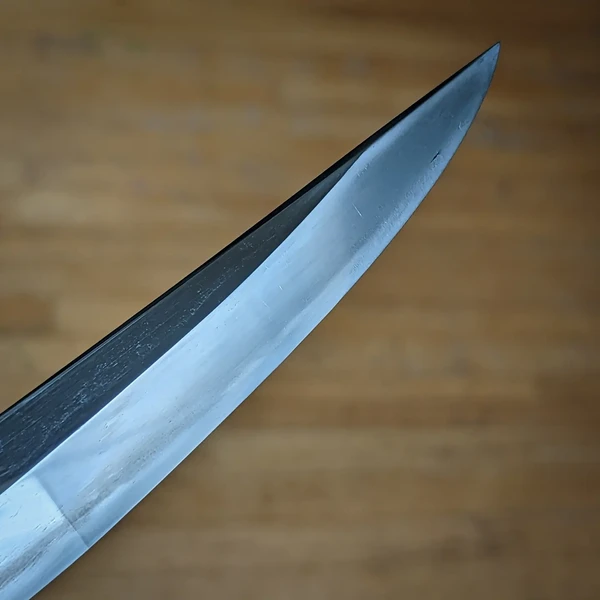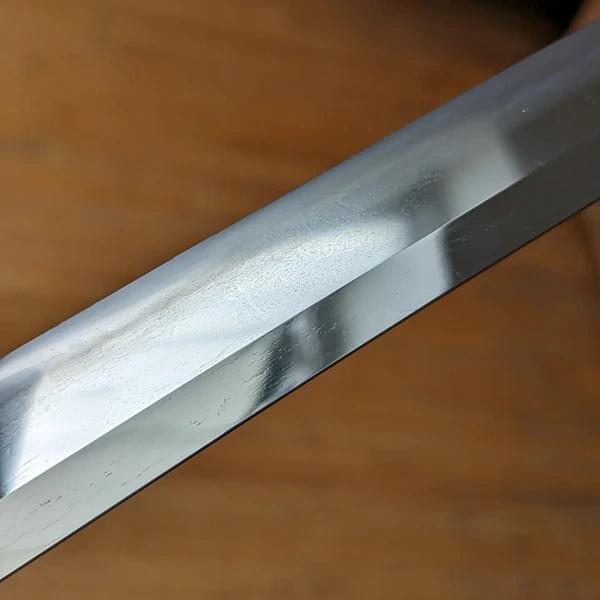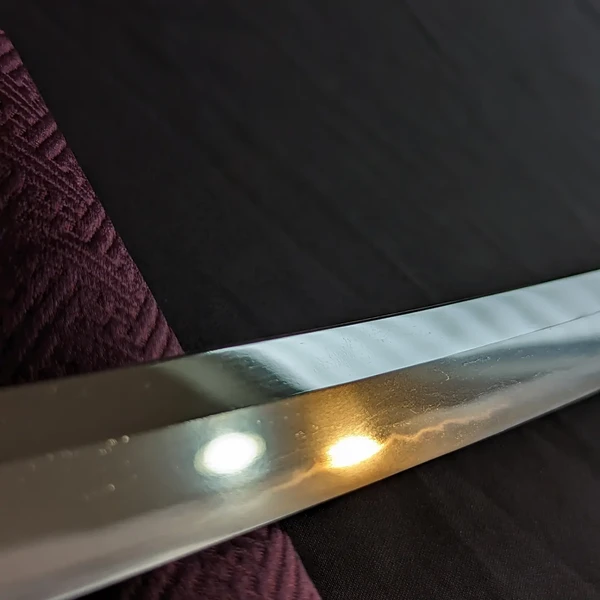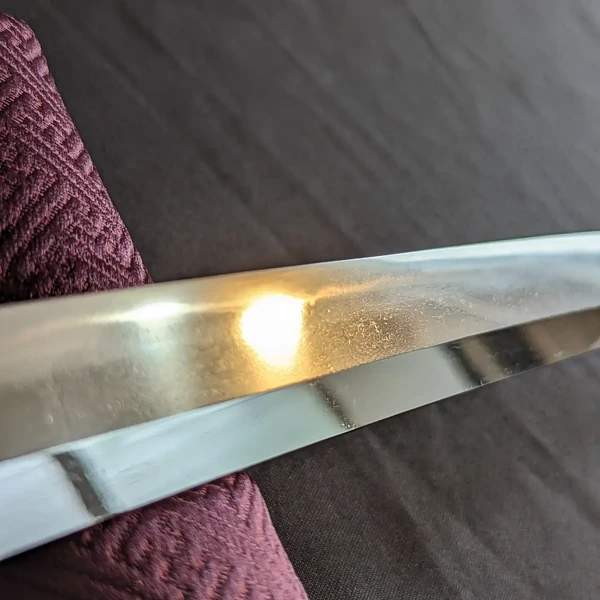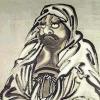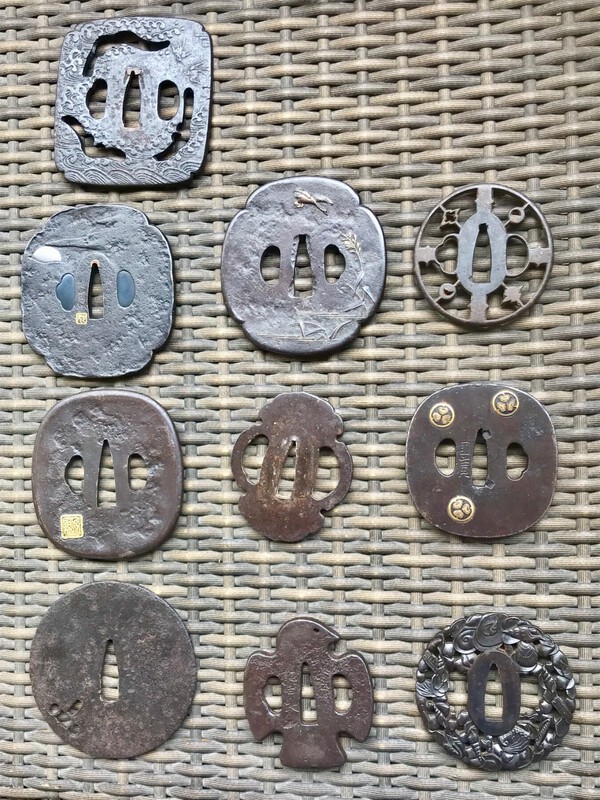Leaderboard
Popular Content
Showing content with the highest reputation on 06/13/2023 in all areas
-
3 points
-
I bought the first tsuba in the pics below a couple of years ago (JB125) and was described as a Higo tsuba, an attribution that I was happy with at the time (and still am) given my limited knowledge. The tsuba is a kikka gata (chrysanthemum shaped) iron sukashi tsuba with a flat migaki-ji (polished) surface with light engraving (kebori: hair carvings) to highlight the blossom and pine tree design. The iron has a black patina with a fine crystalline structure with few apparent inhomogeneous iron inclusions (tekottsu). The design consists of a mixture of cherry (split petals) and plum (rounded petals) blossom with the branch of a pine tree. The sukashi is cut vertically through the plate with no rounding to the edges. The mimi (rim) is defined by the 28-petal chrysanthemum design and there is a slight rounding to the edges. The tsuba has ryu-hitsu, the kogai hitsu being of regular shape and the kodzuka hitsu is bordered by a blossom branch. The nakago ana has no sekigane and shows some widening at the sides and filing at the bottom to fit a blade. The interesting feature is the groups of small, shallow rectangular tagane at the top (four) and bottom (seven) of the nakago ana, which were almost certainly maker’s marks in place of a signature, as the tsuba is mumei. I’ll get back to these later. Statistics: Height: 7.9 cm, Width: 7.4 cm, Thickness (rim): 0.45 cm, Weight: 116 g The design seems to be depict one (or both) of the following stories. The first is the Noh play, Hachi no Ki (the potted trees), in which Lord Tokiyori, disguised as a priest, begs shelter from a former retainer, Tsuneyo Genzayemon, who has fallen on hard times. Tsuneyo and his wife are only able to offer the priest boiled millet for food and, as it is cold and snowing, they chop up their three precious bonsai (plum, cherry and pine) and burn them to keep their guest warm. Six months later Hojo no Tokiyori (ruled at Kamakura 1246-1256) summoned Tsuneyo and granted him three fiefs (Plumfield in Kaga, Cherrywell in Etchu and Pine-branch in Kozuke). The 28-petal chrysanthemum probably alludes to Hojo no Tokiyori. A yukioe print of a scene from the play is by Harunobu is attached. The second theme that this tsuba may relate to is the bunraku and kabuki play ‘Sugawara and the Secrets of Calligraphy’. The main characters of the play are Umemaru (plum tree), Sakuramaru (Cherry Tree), and Matsuomaru (Pine tree). In order to save the son of Sugawara, Matsuomaru used his own son as a decoy who was killed. Anyway, back to the tagane. I started to keep an eye open for tsuba with similar tagane marks and some reliable authentication (e.g. NBTHK). Below are just a couple that I found together with part of an article published by Christian Malterre (sorry Christian, can’t remember where I got this from so that I can acknowledge your work) that attribute these ‘kakushi tagane’ to the two Higo masters: Kamiyoshi Fukanobu and Kamiyoshi Rajuku. There is also an additional tsuba showing these tagane that was for sale on Ebay, but attributed the tsuba to Akasaka. The two tsuba with NBTHK Hozon papers are attributed to ‘mumei kodai Higo (unsigned late Higo)’, which represents quite a wide range of possible makers. Higo (now Kumamoto prefecture in Kyushu, southern Japan) was the home to four major (and numerous lesser) tsuba schools, namely: Hayashi, Hirata, Nishigaki and Shimizu (the founder Jinbei Shimizu renamed the school Jingo, famous for brass inlay). Higo tsuba were highly regarded in the Edo period as illustrated by the old saying ‘For the best katana go to Bizen, for the best tsuba look to Higo’. (Information from Yatsuhiro Municipal Museum website). The pattern of light tagane punch marks is obviously a ‘signature’ rather than an adjustment to the size of the nakago. The NBTHK does not seem to be averse to attributing mumei tsuba to a particular tsubako, but the best that they do with these characteristic marks is ‘Late Higo’, which encompasses a lot of workshops as well as artisans. I have found other examples, but either the photos do not allow close examination of the tagane or the nakago has been modified. My questions are these: Can these particular kakushi tagane marks be attributed to a particular artist/school, or were they used by several (unknown) artists in different workshops over different periods of time? Also were these tsuba faked a lot? Pictures: 1. My tsuba: Omote 2. My tsuba: Ura with tagane 3. Harunobu print of Potted Trees 4. Example 1 5. NBTHK Hozon for Example 1 6. Example 2 7. NBTHK Hozon for Example 2 8. Christian Malterre picture 9. Christian Malterre text 10. ‘Akasaka’ Example Best Regards, John (just a guy making observations, asking questions, trying to learn)2 points
-
A gentle reminder that kogatana are seldom made by the names on them. Usually they are like a tribute to a big name. You'll often find big names on them, no relation to the guy who made it.2 points
-
2 points
-
Announcement of Upcoming Event! Japanese sword and fittings sale livestreamed from Hikone, Japan! Saturday 17th June 2023, starting from around 11:00 am JST until around 3:00 pm JST (Japan standard Time)… New York: Friday 16th June 10:00 p.m. – 2:00 a.m. San Francisco: Friday 16th June 7 p.m. – 11 p.m. Berlin: Saturday 17th 4 a.m. – 8 a.m. Full details available at homepage: www.SuperSamuraiMarket.com (the YouTube live link is available on the homepage) Sword and fittings connoisseurs, Tsuba.info (Paul Kremers) and Keichodo (Robert Hughes) are cooperatively proposing live on-line sales from regional sword exhibitions around Japan. Most international collectors of samurai art are aware of the world renowned Dai Token Ichi, the premier samurai art event in the world. However, what may not be understood is that almost every week there are smaller regional sword exhibitions and events all over Japan. Super Samurai Market offers real time purchasing of regional sword and fittings exhibitions with a YouTube Livestream…. Super Samurai Market is a commercial venue for participants to be able to purchase from Japan all manner of fine samurai art from including swords, sword fittings, and armor. To enable commercial success of this venture, the agents of Super Samurai Market will add a 10% commission fee as well as the shipping fees. For sword purchases, there will also be a processing fee of yen 15,000 to obtain the necessary document for export and Japan customs clearance. Many of the regional Japanese events are cooperative ventures of small groups of dealers. With Super Samurai Market, our intention is to showcase items that are being offered at these events at the existing dealer prices. Therefore, international viewers can see in real time a broad selection of swords and fittings being offered at Japanese domestic prices. With Samurai Super Market, we will act as your purchasing agents to secure fine treasures and deliver them to your address using postal EMS shipping.1 point
-
During last WE at our French Token several tsuba were already sold, among them the ko Tosho, and the jewel one. the following tsuba are very good. Tsuba n°1 - price: 600€ Echizen tsuba. I have never seen the like in 20 years 7,2 x 7,2 cm Iron, deep rich black colour shells design I am leaving Paris from June 20th till August 1st - no shipment during my holidays😄1 point
-
This sword sold to a forum member a while back. He is having some health challenges, and I wanted to list this sword again for him now to resell within the group. This is a sale direct to the new owner, no commission to me. Anyone interested, please let me know and I will connect you with the owner to discuss further. A very nice katana by the shinshinto smith Henmi Yoshitaka. Henmi Kaisai Yoshitaka was a descendant of Bizen smiths. He studied under the swordsmith the Tenryushi Masataka in Settsu, and then returned to Okayama three years later. He also studied carving from from Okayama’s Shoami Katsuyoshi. He became very popular as a sculptor and won the first prize gold cup at the exposition in 1887. He presented a tachi to Emperor Taisho and also gave a sculpture of a large dragon to the Haguro Shrine in Kurashiki City. $8,800 (plus shipping & PayPal) Best regards, Ray1 point
-
$200 that’s a brilliant find, even an Arsenal stamped Gunto is worth $200 ( infact they seem to be going for silly money these days, I’ve seen them selling at auction for £500 or around $700) but this is not a gunto it’s a Nihonto, good find, may be worth seeing if you can get a window Polish ( a small part of the blade polished ) to help study the blade ( before investing in a full Polish) although at the price you paid it would be probably economic to just go for a full Polish anyway).1 point
-
Sam- As the most amateur member on this board, and the guy who is always buying old worn out junk then pestering the good people here to waste their time analyzing it for me - please take everything that I am about to post with Extreme Reservation! I love this sword. The second smaller groove that you are seeing below the main bohi is called a soe-bi. Technically the groove pattern that you have is a koshi-bi with soe-bi. You are right to notice that a faint soe-bi is a great indication of polishing. Like the tread of a tire. Yours doesn't look that that bad, compared to others out there, so that tells me that there is thick enough kawagane surface steel (health) left in this blade for a professional polish to be conducted. There are some deep pits in the kissaki and mune that are going to remain, but I suspect that they may be able to be disguised by a good polisher as "ware" - forging flaws and openings that are typically not a deal killer on koto swords. Generally speaking, old swords get a pass when it comes to imperfections like this. Which brings me to the next topic, age. I think that this is a legit OLD sword. My best guess is that this is a seriously chopped katana. Probably a late Muromachi period (1580's) katana. Swords were shortened ALL the time in the old days prior to about the 1620's. In the late Muromachi period, they were making swords that resembled massive Nanbokucho blades, and the general consensus is that what the smiths in the late Muromachi were going for is something that looked liked shortened Nanbokucho stuff - so that you could buy new and not have to cut up an oldie, but still use it in the same way. I have one of those Muromachi blades in my collection (Echizen Kanenori) has a nagasa of 30", so if it had a serious o-surigae down to wakizashi size, you might not see the original mekugi-ana at all, just like what I THINK is shown here. There is a boshi on this one but it looks to my eye like the the kissaki has been re-shaped as it looks a little thinner than the hamon. That would be consistent with chu-kissaki seen on these late Muromachi, Nanboucho-style katana. For some reason, this sword kinda reminds me of my Kanenori with it's elegant sori, nicely done itame hada (not too big, not too fine, just right), and very tastefully executed bohi. I am a firm believer that ALL of these old things have value. If they are well crafted, that means that somebody dedicated a lifetime of learning to make it, and that passion has value to me. Having nihonto experts express admiration, and subsequent papers is a very important component to learning this subject matter, but you have a GREAT learning tool in your hand right now. I hope that you use it. - - - -Books that you should buy right now (heck I had to use these just to be sure my spelling was correct a few times in this dumb post!): - - - "The Connoissur's Book Of Japanese Swords" by Kokan Nagayama "Encyclopedia Of Japanese Swords" by Markus Sesko Congratulations on a great find! Considering the price that you paid - I would definitely send this out for polish....Ya got nothing to loose. -- JT1 point
-
Does appear to have been made in a hurry,never have seen an o-seppa with such irregular geometry,the nakago shape would make it dificult to get a good wedge fit for the tsuka as well.only an observation not a criticizm. With respect.1 point
-
1 point
-
Another Kai with IJA Company Grade tassel. Apologies if I have posted this in the past. I noticed the inconsistency on the Australian War Memorial website during Covid. I contacted them and they were very accepting...they checked their original records and advised they would add the wording now shown at the end of the first paragraph...good result, but still makes you wonder if the NLF changed tassels during shore duty.1 point
-
Re above. The site (or my phone) allowed a photo but there was no facility for writing anything. Seems to be working again now. The famous Nadeshiko is a kind of oriental carnation, I read. The jagged edges are a characteristic. It was the Saitō family (of Mino) crest but Saitō Dōsan replaced it with the double-topped wave and 2+3 drops of spray.1 point
-
1 point
-
John all the fittings have 3 lines carved into it like on the saya liner. No worries Rob. I know it’s a big job I appreciate the response. I think I’m going to have to have a shirasaya made for the sword when I have it polished and inquire about the liners.1 point
-
Okay Stephen.... Will make a note of your interests... not sure exactly what will surface.....1 point
-
Since I prefer to display my tsuba within their boxes I use these: https://www.ebay.it/...id=710-127635-2958-0 Regards Luca1 point
-
I bought the book "Reborn" from Krystian not really knowing what it shows. I'm very impressed of the 58 pieces that are shown in the book. The book was released, i think 2019 with the exhibition"Reborn" held from the sano art musem in Japan. The blades are shown in the condition were they was found and after the restoration. Pictures of the book is from Krystians website (soryu.pl) So if you find a copy, i can really recommend that book. Thanks to Krystian for the fast sending!1 point
-
1 point
-
1 point
-
Well, for goodness sake! There's your answer in French, 'flowers with five petals'... simples!1 point
-
1 point
-
Hello: I'm not one of the translators so take with a grain of salt but I think it reads Ando Kanemoto saku kore. WW2 smith. Looks like some civilian fittings have been added. John C.1 point
-
Excellent and extremely healthy Nanbokucho period Sa Yasuyoshi katana. In Japanese polish with shirasaya and gold foil habaki. Brilliant nie-deki hamon with deep activity. Flowing itame (itame-nagareru) mixed with tighter itame. Excellent, graceful naginatanaoshi sugata with long kissaki. 69cm nagasa. NTHK kanteisho to Sa Yasuyoshi (with a sayagaki to Sa Yukihiro). YASUYOSHI (安吉), 1st gen., Shōhei (正平, 1346-1370), Chikuzen/Nagato – “Yasuyoshi” (安吉), “Yasuyoshi saku” (安吉作), “Sa Yasuyoshi saku” (左安吉作), “Chikushū-jū Yasuyoshi” (筑州安吉), “Chōshū-jū Yasuyoshi” (長州住 安吉), Sa school, first name Saemonzaburō (左衛門三郎), son of Ō-Sa (大左), he lived in Chikuzen´s Ikihama (隠岐浜) but also worked in Nagato and in Koharu (小春) in Aki province, a tradition says that Ō-Sa also signed with “Yasuyoshi” during his early years but others say that he changed his name to “Yasuyoshi” in later years, however, we know small dimensioned tantō of Yasuyoshi which date around Ryakuō (暦応, 1338-1342) whose niji-mei is different to other Yasuyoshi-mei, so it is possible that they are either early works of this Yasuyoshi or late works of Ō-Sa, some sources even state that Chikuzen Yasuyoshi and Nagato Yasuyoshi were two different smiths, that means the exact affiliation of Yasuyoshi is not certain, we know date signatures from the tenth to the 17th year of Shōhei (1355-1362), there are no tachi but just tantō and hira-zukuri ko-wakizashi extant, most of Yasuyoshi’s tantō are larger dimensioned than those of Ō-Sa what can be explained by the later active period during the heyday of the Nanbokuchō period, the jigane is an excellently forged tame mixed with mokume and bō-utsuri, some blades show itame-nagare and shirake, the hamon is a notare with gunome or a koshi-no-hiraita gunome-chōji that reminds of Bizen Kanemitsu (兼光), the jiba of Yasuyoshi is not that bright and clear as that of Ō-Sa, the bōshi is a pointed midare-komi which can either be interpreted like at Ō-Sa or like at Kanemitsu, the tip of the tang is a kurijiri, the yasurime are sujikai, and the signature is mostly a large niji-mei chiselled below of the ubu-mekugi-ana, the character for “Yasu” tends to a cursive script, it is said that he used the pseudonym Yukioni (行鬼), ō-wazamono, jōjō-saku $17,000 (plus shipping & PayPal)1 point
-
That’s my suspicion too, Hamish. There is no way someone put an “old samurai blade“ in these fittings. Just trying to be nice until the guy produces more evidence.1 point
-
Flame roasted,nice back cut of habaki,gently honed with exquisite 600 grits as a side😇what a dish1 point
-
1 point
-
Posting some of the photos available for discussion His description: Original/Reproduction: Original Region of Origin: Japan ww2 Japanese officers sword. With old samurai blade 40 1/8 in scabbard 25 5/8 blade1 point
-
Maybe you will like this one https://www.imdb.com/video/vi1769977881/?playlistId=tt7451284&ref_=tt_ov_vi1 point
-
I can absolutey understand your anger! While many people are struggling to make their living, it is only fair to think of the means we are using, and the work that is necessary (and done by others!) to keep everything running smoothly. It is certainly not too difficult to understand that.1 point
-
Very good recommendation Chris. I got mine from Krystian too and there are some very rare items featured in that book that I haven't encountered yet in other books.1 point
-
A long term seller here....always making private offers to just about every newcommer who posts a sword here. Does MANY private deals over the years..always has plenty of items on sale. Posts SEVENTY tsuba for sale today. Not just one bulk pic....38 replies with pics of ALL of them over 2 pages. This combined with the 30+ other items already on offer. So when I hide the tsuba post and politely mention that maybe a Gold Membership would be appropriate for someone listing over 100 items here and who has never really supported the forum.... I get told that since none of the items sold, and that hosting fees over there in Europe are so cheap...it is implied that I am being greedy asking for at least some support? OVER 1000 Pm's going out regularly from this account. A second account already registered under a different name, already sending out hundreds of pm's. A fake name. A competing Nihonto forum in the works.... NO. I refuse to allow people to take advantage of this place and the people that participate here. From now on, people who take advantage and refuse to contribute....gone. And I WILL start to charge for abusing this place if it continues to be a drag on my finances. There is no reason I shouldn't gain some small benefit from the hours I spend here! Anyone who thinks I'm greedy for suggesting monetary support for what amounts to easy info and access to thousands of collectors and customers....you are welcome to try doing this yourself. Thank you to that German member who decided that listing over 100 items is not worth $60 a year. You're either very selfish, or a shit dealer. Either way, finish off your deals. Sorry for the outburst folks. But if I'm going to have to deal with stress like this, there has to be an upside. /rant0 points
-
Oh, man, now that's what I call hada! Wish I had the entry fee. Say, what does a kidney go for now? In the meantime, good luck with your sale.0 points
-
Simon, of course we could all immigrate into Japan, but to have these advantages, how do we manage the difficult thing with a wonderful wife?0 points
This leaderboard is set to Johannesburg/GMT+02:00


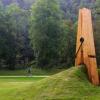

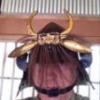
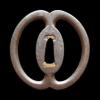
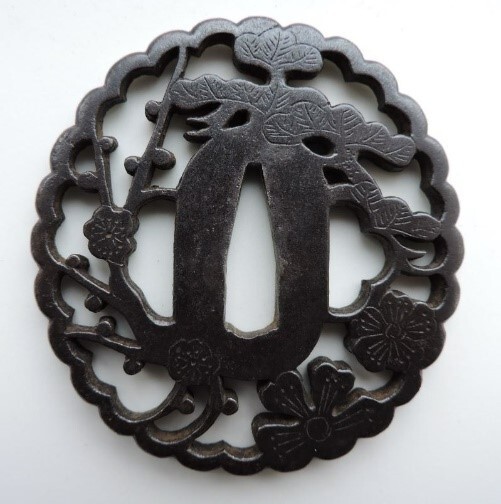









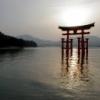
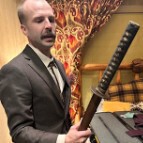



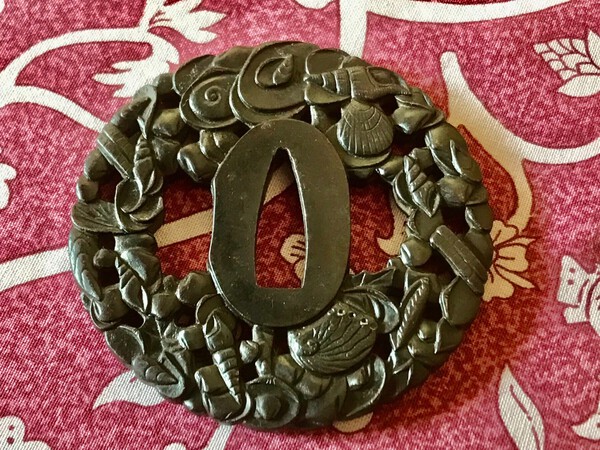
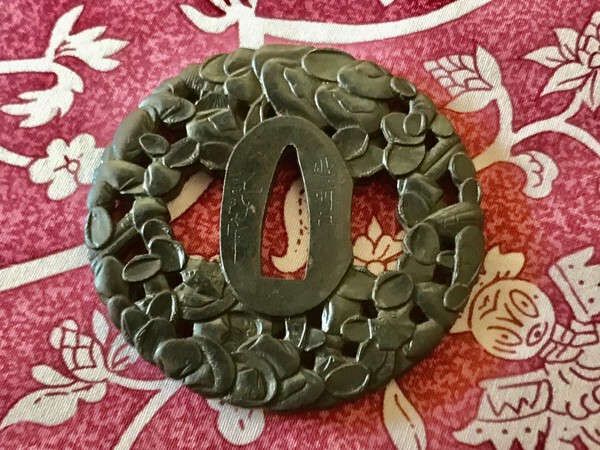
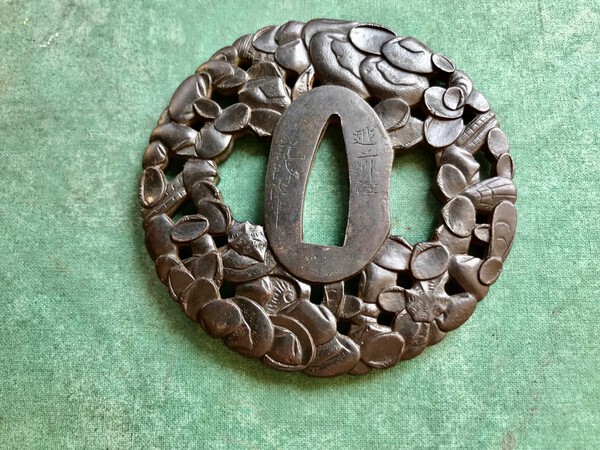




.thumb.jpg.bb6e8d44f5213ef69af611b34137c443.jpg)

